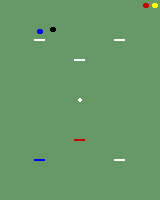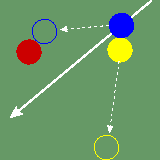Now we delve into the obscure topic of cannons. Generally speaking, a cannon is any stroke involving more than two balls. Using a cannon to pick up a break in American rules is rare indeed. Useful opportunities don't come up often, and most players don't recognize them anyway.
So this section is more “bag of tricks” than “bread and butter”. Still, these techniques can be useful on occasion. And I find it particularly satisfying to use unusual tricks like these to pick up a break that the opponent never saw coming.
Psuedo-cannons
A “psuedo-cannon” (or “open cannon” (1)) is a croquet stroke in which the striker’s ball makes a rush on a third ball. This is sometimes the best way of getting two boundary balls well into the court.
The most dramatic use of the psuedo-cannon is to create a break when you don't have a ball at your hoop, and the opponents are joined on the boundary. One opponent ball is sent to the pioneer hoop, and on the same stroke the second ball is rushed to the striker’s current hoop. This requires a very particular configuration, such as the one pictured in Diagrams 3a and 3b. It works best with the two balls about nine inches apart, which of course is common in American rules.

|
Diagram 3aThe setup: Blue has just run #2. There are many options, but the best is one that most players would overlook: the psuedo-cannon to start a break. |

|
Diagram 3b (corner III detail)Having rushed black to near #3, blue has taken off and roqueted yellow, and is now prepared to play the psuedo-cannon. The stroke is played as a maximum-angle split shot, with either a stop-shot or drive-shot action, swinging in the direction shown by the solid white line. Pull must be taken into account when placing blue for the stroke. If played correctly, yellow will go to #4 and blue will rush red to #3. Quite simple, really! |
A more mundane use of the pseudo-cannon is to get two boundary balls well into the court. When you already have a ball at your hoop and the other three balls are close together on the boundary, a pseudo-cannon is often the best way to get all the balls into play, much better than stop-shotting the first ball into the court and then roqueting the second ball. Such an opportunity might arise after you have set a “killer leave” (2) and the opponent has shot at you on the boundary. Or it may come up after a failed attack by the opponent.
Promotion cannons
Now we’re getting really obscure. Some advanced players will occasionally use a promotion cannon—roqueting or croqueting a ball into another ball—to bring a ball into the game, to knock an opponent out of position, or to adjust the balls during a peeling break, but using a promotion cannon to create a break is rare indeed in American rules. Diagram 3c shows one of the few such situations I have seen. The opponent had rolled out of bounds on an attack. I was able to promote the in-court ball to my hoop, then use the fourth ball to start my break. This was only a pickup game—I'm still waiting for my first chance to try this in a tournament!

|
Diagram 3c (corner III detail)Blue was trying for a standard attack, but rolled black out of bounds. Red is for #3 (the hoop shown in the diagram). Red roquets yellow, then croquets yellow into blue to promote it to #3. Red then roquets black and has a three-ball break. |
Notes
- The terms “psuedo-cannon” and “open cannon” (both describe the same thing) come from International rules, where a normal cannon starts from three balls in contact. The International rules cannon is impossible in American rules, hence “open cannon” makes no sense in this context. “Psuedo-cannon” isn't ideal either, but I've stuck with it to avoid inventing a new term. It does have a certain logic, differentiating cannons in which the striker’s ball hits the third ball from those in which a roqueted or croqueted ball does so.
- The “killer leave” is described in detail in my article Practicing and playing leaves in USCA croquet, available at http://ipsedixit.net/croquet/articles/leaves/.
Copyright notice
Copyright 2002–2008 by Jeff Soo.
Posted December 1, 2002